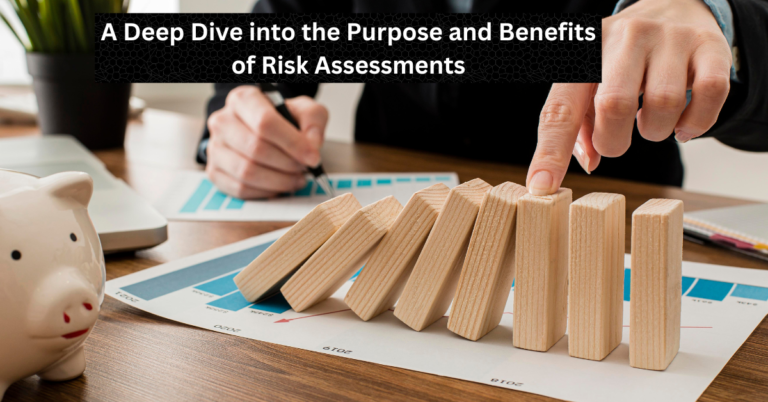Risk Assessment Training in Kerala: A Strategic Investment for Businesses
Introduction
Do you know which tool ensures the health and safety of workers and others? Risk assessment is the key management tool for that purpose.
If you’re wondering how to complete a risk assessment or are unsure of their relevance within your industry, then here’s our gift to you.
Learn everything you need to know about risk assessment and why it is important to your business.
Ready? let’s dive in.
What is risk assessment?
According to the labor force survey report, 581,000 working people have sustained an injury. Implementing risk assessments within your organization can help you limit any injuries you or your employees may face.
After you get training in risk assessment, you will learn what risk assessments are as well as how and when to perform them.
It teaches you about the advantages of comprehensive risk assessments and how to comply with basic legislation.
The systematic process of identifying hazards and analyzing any potential risks at work, followed by the implementation of practical control measures to eliminate or reduce those hazards, is known as risk assessment.
You might need more training if you need to finish or reevaluate your risk management procedures.
A risk assessment will help ensure that it is appropriate and sufficiently detailed if you complete training like our IOSH fire risk assessment training courses.
If you are searching for a good institute to join risk assessment training in Kerala, there is nowhere to go. You are here in the right place. Ensign Academy provides quality risk assessment training to safeguard your workplace.

Get awareness about different types of risk assessment
Any workplace’s risk assessment requirements should be proportionate and pertinent to the operational activities being carried out. Specific statutory requirements are applicable in many industries.
For instance, a Control of Substances Hazardous to Health Assessment (COSHH) should be completed in settings where hazardous substances are used.
Some common types of risk assessments include:
- Fire risk assessments: It is necessary to establish fire safety management procedures in all workplaces, including a sufficient and appropriate fire risk assessment.
- Manual handling risk assessment: A manual handling risk assessment should be performed in any workplace where lifting, carrying, and moving loads puts an employee at risk for an injury or other health problem.
- Display screen equipment (DSE) risk assessments: This must be completed in workplaces where staff members (and others) use computers, laptops, etc.
- COSHH risk assessments: Workplaces that store, use, or produce hazardous materials are required to conduct COSHH risk assessments.
Depending on the type of operations being conducted, a business may also decide to complete a Risk Assessment Method Statement (RAMS).
This process includes information on the risk as well as a step-by-step guide for completing the work and effectively controlling the risks noted. Within the construction sector, this method is frequently employed.
Who needs this risk assessment training?
Risk assessment training is for those who work in any industrial environment. It can also be useful for new graduates from practical faculties like Engineering, Science, etc. And this course is a must for those who work in safety and health.
- Usually, competent people take risk assessment training, which is exactly what you will become after finishing this course.
- An organization without risk assessment can be considered punishable by the government.
- In the event of an accident or loss, you should have your risk assessment ready, or you will be in big legal trouble.
- A risk assessor is highly esteemed in any organization.
- There is no doubt that this course is like a gemstone in your resume.
Why is risk assessment the need of the hour in every company?
Risk assessments are at the core of all successful health and safety policies. Successful implementation of risk assessment in your workplace can assist your business in transforming hazardous sites into safe workplace environments.
To carry out the risk assessment process, five steps involve identifying any hazards that could cause accidents, injuries, or ill health.
Next is the proper analysis of the level of risk and likelihood of incidents occurring, and we should implement effective control measures with monitoring.
Additionally, all company levels must be informed of the results of the risk assessment. Employers in all sectors of the economy can use these steps to ensure the security of their workplace and safeguard employees.
There are risks in every workplace environment that could result in serious illnesses or injuries. Wet floors, hazardous tools, the use of dangerous substances, exposure to fire hazards, and other factors can all pose risks.
Risk assessment training, however, can significantly lower the likelihood of work-related illnesses and accidents. They educate employees about dangers and the risks they pose, and they support employers in finding solutions to reduce health and safety risks.
Don’t be trapped in poor risk management, as it results in unnecessary costs
Poor risk management may drain the income of your company, which puts a huge financial strain on businesses.
Employees must take time off if they suffer illnesses or injuries at work, and employers may be required to pay for employment benefits such as sick pay.
Affected parties may seek compensation, and the Health and Safety Executive (HSE) may impose fines on businesses that violate health and safety laws, so there may also be legal costs to consider. The cost of insurance may go up as a result of these penalties.
In short, we can say that a thorough risk assessment and steps to reduce the assessed risks can help to avoid accidents and illness—and the costs that come with them.
An updated risk assessment can also show compliance with the HSE, preventing fines for subpar health and safety.
The Bottomline
Now you understand the importance of risk assessment in your business. There is no doubt that it is a strategic investment for your business.
First of all, risk assessment is a legal necessity and an essential process to be implemented in any workplace.
Don’t let the technicality get to your head. Simply put, it involves thinking ahead to determine what we would do to avoid harm, how we could stop any losses of personnel or equipment, and how we could maximize profit from the industrial process.





